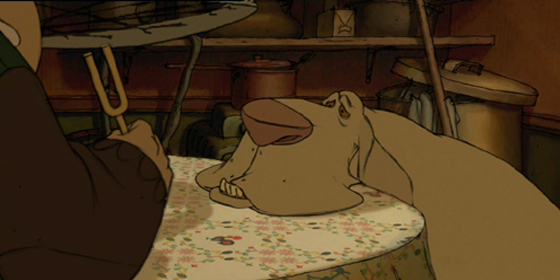The Triplets of Belleville is a pretty great movie. It's darkly comical and brings the European style of caricature into film. Everything depicted is a grotesque exaggeration of its real life counterpart. But what I'd like to talk about today is a small storytelling trick I appreciated near the beginning, to do with the way they handle exposition. Exposition isn't just dialogue. In fact, the more exposition you can portray
without dialogue, the better. But whatever form it takes, too much of it can be exhausting and boring for the audience. That's why I took note of a particular scene in Triplets of Belleville that managed to deliver a lot of information to the audience while still being engaging.
We've just jumped forward about twenty years in the story, and there's a lot to explain. The movie needs to tell us that the kid is now training for the Tour de France, that his grandmother is helping him, that she blows her whistle to encourage people, that a massive city has sprung up around the grandmother's house, including a train track nearly knocking the home over, that the dog doesn't like trains, that their exercise equipment is rudimentary at best, that the grandmother is good at tuning strings, and that she still babies her grandson. That's a lot of info to get across. Indeed, this scene runs between five and ten minutes, and includes no plot-relevant character choices. It's all just exposition. The only thing that keeps us interested in this scene is the dog.
 |
| wof |
It's notable here that the viewpoint character of this scene is the dog. Not the grandmother. Not the grandson. The dog. We open with him, barking at the train, and we close with him, sleeping all butt-up-on his master. There's cutaways to other characters, sure, but a significant portion of the scene is shot from the dog's perspective. The purpose of this is to create a complete narrative purely within this one scene. Our viewpoint character has a conflict and overcomes it during the course of this scene. Granted, our viewpoint character is a dog, and the conflict is that he's hungry, but if you plot it out, this one scene follows the same narrative arc of any film.
 |
BEST ORIGINAL SCREENPLAY
|
Yeah, it's not a brilliant plot like
The Godfather or
Back to the Future*, but it doesn't need to be. All it's gotta do is keep us engaged long enough to set up the plot. This might seem a little ridiculous to you, but admit it: you were screaming WHEN ARE THEY GONNA FEED THE DOG in your head the entire scene. So gosh darn it if it didn't work. And that's the lesson of this scene. Always have some sort of conflict in every scene of your movie. It doesn't have to be an in-universe conflict that the hero has to overcome. It can be a conflict between the movie and the viewer. Contrast the information the viewer has with the information they want to have for a good old mystery. Create hitchcockian suspense by creating a conflict between what the audience knows and what the hero knows. Just as long as there is some tension, some barrier to overcome or some question to answer, the viewer will want to keep watching.
*Back to the Future is one of the most tightly plotted films ever. I will fight you on this shit.


No comments:
Post a Comment